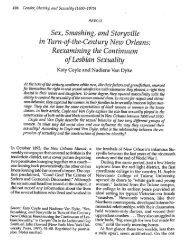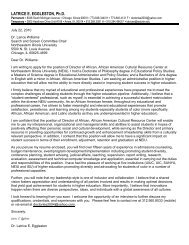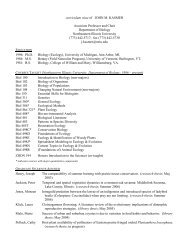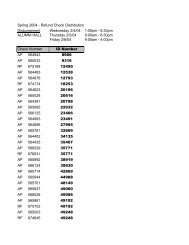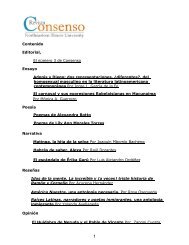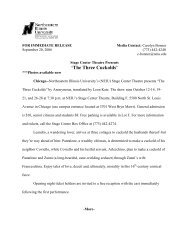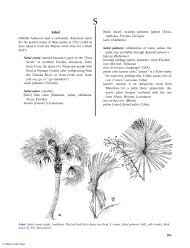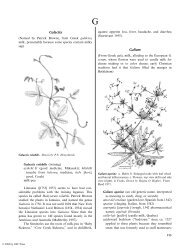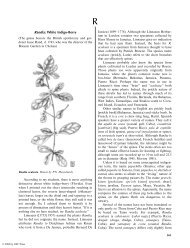Herba Cana - Northeastern Illinois University
Herba Cana - Northeastern Illinois University
Herba Cana - Northeastern Illinois University
Create successful ePaper yourself
Turn your PDF publications into a flip-book with our unique Google optimized e-Paper software.
© 2004 by CRC Press<br />
The Ethnobotany 479<br />
Panicum hemitomon. From Institute of Food and Agricultural<br />
Sciences.<br />
Panicum laxiflorum (loosely flowered) (as<br />
P. xalapense) ( /Dichanthelium laxiflorum)<br />
open-flower witch-grass [openflower witchgrass]<br />
(Florida)<br />
soft-tufted panic-grass [soft-tufted panicgrass]<br />
Panicum strigosum (with appressed hairs) (as<br />
P. polycaulon) ( /Dichanthelium strigosum)<br />
cofimássi (cufe, rabbit, em, its, vsse, dried leaves,<br />
Creek); cokfimasí (cokfí, rabbit, im, its, híssi,<br />
leaves, Koasati); cokfímpatâ:kî [tcokfwimpataki]<br />
(rabbit’s bed, Mikasuki)<br />
cushion-tufted panic-grass [cushion-tufted panicgrass]<br />
rough-hair witch-grass [roughhair witchgrass]<br />
(Florida)<br />
Hogan (1978) found pollen of Panicum hemitomon<br />
in the coprolites of the Glades people that she studied.<br />
As they were living beside vast stands of the windpollinated<br />
plants, that is no clear indication that they<br />
used the grass. However, being in a pre-Columbian<br />
context and having historical documentation of use is<br />
provocative. The Seminoles too know these formerly<br />
abundant grasses (Sturtevant 1955), and at least use<br />
them to the extent of ‘‘reading’’ the landscape. Where<br />
there is pahitóɬ piɬ ó:cî, they know that the water<br />
remains near a certain depth. That constitutes part<br />
of their knowledge of the landscape.<br />
Because of doubtful identifications, Moerman<br />
(1998) placed all the grasses used by the Creeks,<br />
Natchez, and Seminoles under Panicum sp. However,<br />
the species recorded by Sturtevant (1955) are reliably<br />
known. Since Sturtevant (1955) indicated that a third<br />
species was similarly used, perhaps others were used<br />
by the Seminoles’ relatives, the Creeks.<br />
The Creeks and Natchez used a Panicum leaf<br />
infusion for fevers, especially malaria (Swanton 1928a,<br />
Taylor 1940). Symptoms of those diseases are close<br />
enough to the Seminole malady called ‘‘Gopher<br />
Tortoise Sickness’’ (cough, dry throat, noisy chest)<br />
to suggest that the Creeks and Natchez used the same<br />
grasses. The Seminoles also used cokfímpatâ:kî for<br />
‘‘Rabbit Sickness’’ (muscle cramps) (Sturtevant 1955).<br />
The Cherokee used some Panicum, possibly more<br />
than one species, for padding inside their moccasins<br />
(Hamel and Chiltoskey 1975).<br />
Parietaria<br />
(Linnaeus based this on Latin parietis, a wall, in<br />
reference to its frequent occurrence there)<br />
bartram [bertram] (an English corruption of<br />
Greek pyrethrum, from pyros, fire; the name<br />
was originally given to Anacyclus pyrethrum or<br />
pellitory of Spain by at least 1578 with Henry<br />
Lyte’s translation of Dodoens’s Cruydeboek of<br />
1554; later the name became secondarily applied<br />
to Parietaria, because both were called pellitory)<br />
blidnesle (gentle nettle, Norwegian)<br />
Glaskraut (glass herb, German)<br />
lus a’ bhalla (wall herb, Gaelic)<br />
parietaria (from Latin parietis, Italian, Spanish);<br />
parietária (Portuguese); pariétarie (French); pellitory<br />
(from Latin parietis)<br />
Parietaria floridana (from Florida)<br />
herbe à murailles (wall herb, Haiti)<br />
herbe gras (fat herb, Haiti)<br />
paille à terre (country straw, Haiti)





